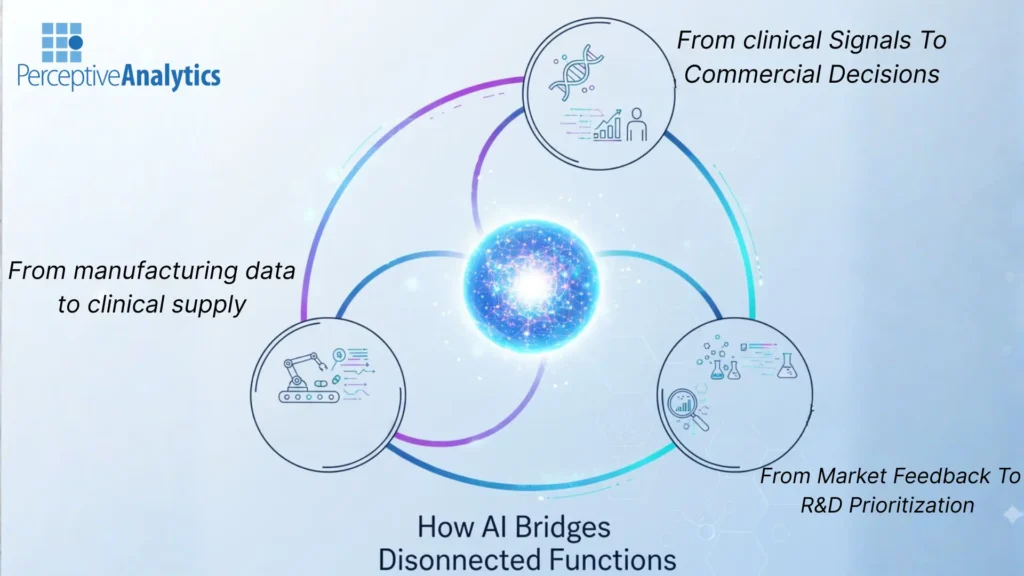The Bottleneck Pharma Doesn’t Talk About
For years, drug development felt like building bridges—each stage set apart, each team on its own island.
- “We were sitting on mountains of data and barely scratching the surface.” — Anonymous Pharma Scientist
- Data from R&D rarely informed clinical trial design beyond the basics.
- Manufacturing operated without real-time signals from clinical progress or market demand.
- Commercial teams often launched products without critical feedback from patient outcomes.
Key consequence: Lost insights, lagging timelines, and missed commercial opportunities.
Today that’s changing.
AI is dissolving the walls between functions, connecting molecules to markets through a single, intelligent data fabric.
This isn’t an IT upgrade. It’s a complete rewiring of how therapies are conceived, tested, and launched.
“The future of pharma isn’t just digital — it’s unified.”
— Pharma Intelligence 2026, Perceptive Analytics
Read more about decision intelligence in pharma — Beyond Dashboards: The Rise of Decision Intelligence in Pharma
Why Unified Data Architectures Are Pharma’s Future
The traditional sequential model is no longer sustainable.
R&D teams explore compounds without knowing manufacturing constraints.
Clinical teams design protocols without visibility into market signals.
Commercial teams launch without feedback from trial outcomes.
This fragmentation slows innovation and raises costs.
A unified data architecture changes that.
It creates a single, connected ecosystem — where genomics, clinical, supply-chain, and commercial data converge into one source of truth.
With unified data, pharma teams can:
Accelerate R&D: Prioritize Compounds with Clinical and Commercial Viability
- Unified data allows R&D teams to quickly identify which compounds have the best chance of success—not just in the lab, but in the real world.
- By combining genomic data, clinical trial results, and market analytics, scientists can focus on molecules that address unmet needs and show strong commercial potential.
- AI models can flag promising candidates early, reducing wasted effort on compounds unlikely to succeed in later stages.
- Teams can also simulate market adoption, helping them choose the most impactful projects before investing heavily.
Streamline Operations: Align Manufacturing with Real-Time Trial Progress and Demand Forecasts
- Manufacturing is no longer a separate, siloed function. With unified data, production teams get live updates on trial enrollment, patient response, and supply chain bottlenecks.
- Predictive analytics help forecast how much drug will be needed, where, and when—preventing shortages and overproduction.
- AI-driven scheduling ensures that every batch is produced efficiently, minimizing downtime and maximizing resource use.
- This alignment means faster scale-up for successful drugs and quicker pivots for those that don’t meet expectations.
Optimize Commercial Launches: Adapt Strategy Dynamically Based on Patient Outcomes and Physician Feedback
- Commercial teams can now launch products with a deep understanding of patient needs, physician preferences, and real-world outcomes.
- Unified data platforms provide instant feedback from early adopters, allowing marketing and sales strategies to be fine-tuned on the fly.
- AI analyzes physician sentiment, patient reviews, and insurance claims to spot trends and emerging issues.
- This dynamic approach leads to more effective launches, better patient engagement, and higher market share.
According to McKinsey, generative AI could unlock $60 – $110 billion annually in value for the pharmaceutical sector — but only if companies break down their data silos.

Check out how responsible AI builds trust in pharma — AI Without Trust Is Noise: Building Responsible Intelligence in Pharma
How AI Bridges Disconnected Functions
AI is the connective tissue of the new pharmaceutical enterprise.
Machine learning, natural-language processing, and predictive analytics weave together insight flows that once lived in isolation.
From Clinical Signals to Commercial Decisions
AI models analyze early-phase trial data to predict market adoption potential.
By spotting patient segments most responsive to treatment, commercial teams can pre-build targeting, patient-support, and pricing strategies months before approval.
From Market Feedback to R&D Prioritization
AI scans real-world data — EHRs, insurance claims, even social conversations — to identify unmet needs and gaps in current therapy options.
This continuous feedback loop keeps the R&D pipeline aligned with patient and market realities.
From Manufacturing Data to Clinical Supply
Predictive AI ensures supply meets demand.
By forecasting enrollment rates and drug requirements across global trial sites, it prevents stockouts and keeps studies on schedule.

Real-World Proof: AI in Action
Pfizer’s Predictive Manufacturing Revolution
Pfizer uses AI-driven predictive maintenance and production scheduling to minimize downtime and balance global demand.
During the COVID-19 vaccine rollout, this connected approach helped Pfizer scale manufacturing in record time — turning its plants into responsive data ecosystems.
Adaptive Clinical Pipelines
AI is reshaping the trial model.
Adaptive designs can now adjust enrollment criteria in real time based on interim data — focusing resources on responsive patient groups.
Experts suggest this can cut trial durations by up to 50 percent while boosting success rates.
IQVIA’s Real-Time Market Feedback Loop
AI-powered platforms at IQVIA analyze healthcare-professional sentiment and engagement in real time.
Commercial teams can now see market shifts as they happen — fine-tuning messages, countering competitors, and keeping every campaign relevant.
Why data‑speed gives pharma a competitive edge — The ROI of Decision Velocity: Why Data Speed Defines Pharma’s Next Competitive Edge
AI Is the New Connective Tissue
For pharmaceutical leaders, the message is clear:
AI is no longer a set of smart tools — it’s the central nervous system of the modern enterprise.
The next generation of pharma leaders won’t manage data; they’ll orchestrate intelligence.
To get there, organizations must:
1 Champion data sharing across functions and partners.
2 Invest in explainable AI for trust and compliance.
3 Build Decision Velocity — the organizational muscle that turns insight into action.
“The leaders of 2026 won’t just make faster decisions — they’ll make connected ones.”
— Perceptive Analytics Leadership Team
